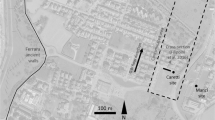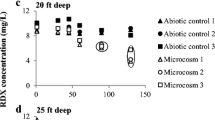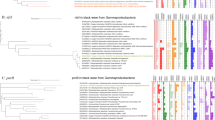Abstract
Thus far, members of the genus Dehalococcoides are the only microorganisms known to dehalogenate chlorinated ethenes to ethene and thereby detoxify these common groundwater pollutants. Therefore, it is important to characterize the taxonomic and functional diversity of these key microorganisms and their reductive dehalogenase (RDase) genes in contaminated aquifers for assessing the natural attenuation potential. Little is known about the diversity of RDase genes under field conditions or in laboratory systems under selective pressure during dechlorination activities. Here, we evaluate the diversity of Dehalococcoides sp. and three RDase genes in groundwater as well as in water from a constructed wetland and microcosms setup with contaminated groundwater from the same field site in Bitterfeld (Saxony-Anhalt, Germany). The presence and relative abundance of Pinellas and Cornell subgroups of Dehalococcoides was evaluated by a novel direct sequencing method, which revealed that all sequences were identical and affiliated to the Pinellas subgroup. Contrarily, our results showed remarkable differences at the functional gene level between the systems. Of the vinyl chloride reductase genes, vcrA was detected in samples from the groundwater, wetland, and microcosms, whereas bvcA was only found in wetland and microcosm samples. The trichloroethene dehalogenase gene, tceA could not be detected at all, although complete dehalogenation activity of higher chlorinated ethenes was observed. Our study demonstrates that although the Dehalococcoides 16S rRNA gene sequences retrieved from the investigated systems were identical, the RDase gene diversity varied among the systems, according to the spectrum of the chlorinated ethenes present.


Similar content being viewed by others
References
Altschul, S. F., Madden, T. L., Schaffer, A. A., Zhang, J., Zhang, Z., Miller, W., et al. (1997). Gapped BLAST and PSI-BLAST: A new generation of protein database search programs. Nucleic Acids Research, 25(17), 3389–3402.
Bradley, P. M. (2003). History and ecology of chloroethene biodegradation: A review. Bioremediation Journal, 7(2), 81–109.
Cichocka, D., Nikolausz, M., Haest, P. J., & Nijenhuis, I. (2010). Tetrachloroethene conversion to ethene by a Dehalococcoides-containing enrichment culture from Bitterfeld. FEMS Microbiology Ecology, 72(2), 297–310.
Christ, J. A., Ramsburg, C. A., Abriola, L. M., Pennell, K. D., & Löffler, F. E. (2005). Coupling aggressive mass removal with microbial reductive dechlorination for remediaton of DNAPL source zones: A review and assessment. Environmental Health Perspectives, 113(4), 465–477.
Dugat-Bony, E., Biderre-Petit, C., Jaziri, F., David, M. M., Denonfoux, J., Lyon, D. Y., et al. (2012). In situ TCE degradation mediated by complex dehalorespiring communities during biostimulation processes. Microbial Biotechnology, 5(5), 642–653.
Duhamel, M., Mo, K., & Edwards, E. A. (2004). Characterization of a highly enriched Dehalococcoides-containing culture that grows on vinyl chloride and thrichloroethene. Applied and Environmental Microbiology, 70(9), 5538–5545.
Futagami, T., Okamoto, F., Hashimoto, H., Fukuzawa, K., Higashi, K., Nazmul Hussain Nazir, K. H. M., et al. (2011). Enrichment and characterization of a trichloroethene-dechlorinating consortium containing multiple Dehalococcoides strains. Bioscience, Biotechnology, and Biochemistry, 75(7), 1268–1274.
Habash, M. B., Trevors, J. T., & Lee, H. (2004). Bacterial reductive dehalogenases. In A. Singh & O. P. Ward (Eds.), Biodegradation and Bioremediation (pp. 198–233). New York: Springer.
He, J., Ritalahti, K. M., Aiello, M. R., & Löffler, F. E. (2003). Complete detoxification of vinyl chloride by an anaerobic enrichment culture and identification of the reductively dechlorinating population as a Dehalococcoides species. Applied and Environmental Microbiology, 69(2), 996–1003.
He, J., Sung, Y., Krajmalnik-Brown, R., Ritalahti, K. M., & Löffler, F. E. (2005). Isolation and characterization of Dehalococcoides sp. strain FL2, a trichloroethene (TCE)- and 1,2-dichloroethene-respiring anaerobe. Environmental Microbiology, 7(9), 1442–1450.
Heidrich, S., Weiss, H., & Kaschl, A. (2004). Attenuation reactions in a multiple contaminated aquifer in Bitterfeld (Germany). Environmental Pollution, 129, 277–288.
Hendrickson, E. R., Payne, J. A., Young, R. M., Starr, M. G., Perry, M. P., Fahnestock, S., et al. (2002). Molecular analysis of Dehalococcoides 16S ribosomal DNA from chloroethene contaminated sites throughout North America and Europe. Applied and Environmental Microbiology, 68(2), 485–495.
Heuer, H., Krsek, M., Baker, P., Smalla, K., & Wellington, E. M. (1997). Analysis of actinomycete communities by specific amplification of genes encoding 16S rRNA and gelelectrophoresis separation in denaturing gradients. Applied and Environmental Microbiology, 63(8), 3233–3241.
Imfeld, G., Nijenhuis, I., Nikolausz, M., Zeiger, S., Pachke, H., Drangmeister, J., et al. (2008). Assessment of in situ degradation of chlorinated ethenes and bacterial community structure in a complex contaminated groundwater system. Water Research, 42(4–5), 871–882.
Imfeld, G., Aragones, C. E., Fetzer, I., Mészáros, É., Zeiger, S., Nijenhuis, I., et al. (2010). Characterization of microbial communities in the aqueous phase of a constructed model wetland treating 1,2-dichloroethene-contaminated groundwater. FEMS Microbiology Ecology, 72(1), 74–88.
Imfeld, G., Pieper, H., Shani, N., Rossi, P., Nikolausz, M., Nijenhuis, I., et al. (2011). Characterization of groundwater microbial communities, dechlorinating bacteria, and in situ biodegradation of chloroethenes along a vertical gradient. Water, Air, & Soil Pollution, 221(1–4), 107–122.
Kaufhold, T., Smidt, M., Cichocka, D., Nikolausz, M., & Nijenhuis, I. (2012). Dehalogenation of diverse halogenated substrates by a highly enriched Dehalococcoides-containing culture derived from the contaminated mega-site in Bitterfeld. FEMS Microbiology Ecology, 83(1), 176–188.
Krajmalnik-Brown, R., Hölscher, T., Thomson, I. N., Saunders, F. M., Ritalahti, K. M., & Löffler, F. E. (2004). Genetic identification of a putative vinyl chloride reductase in Dehalococcoides sp. strain BAV1. Applied and Environmental Microbiology, 70(10), 6347–6351.
Krajmalnik-Brown, R., Sung, Y., Ritalahti, K. M., Saunders, F. M., & Löffler, F. E. (2007). Environmental distribution of the trichloroethene reductive dehalogenase gene (tceA) suggests lateral gene transfer among Dehalococcoides. FEMS Microbiology Ecology, 59(1), 206–214.
Lane, D. J. (1991). 16S/23S rRNA sequencing. In E. Stackebrandt & M. Goodfellow (Eds.), Nucleid acid techniques in bacterial systematics (pp. 115–173). New York: Wiley.
Lendvay, J. M., Löffler, F. E., Dollhopf, M., Aiello, M. R., Daniels, G., Fathepure, B. Z., et al. (2003). Bioreactive barriers: A comparison of bioaugmentation and biostimulation for chlorinated solvent remediation. Environmental Science & Technology, 37(7), 1422–1431.
Lovley, D. R. (2003). Cleaning up with genomics: Applying molecular biology to bioremediation. Nature Reviews Microbiology, 1, 35–44.
Löffler, F. E., & Edwards, E. A. (2006). Harnessing microbial activities for environmental cleanup. Current Opinion in Biotechnology, 17(3), 274–284.
Löffler, F. E., Yan, J., Ritalahti, K. M., Adrian, L., Edwards, E. A., Konstantinidis, K. T., et al. (2012). Dehalococcoides mccartyi gen. nov., sp. nov., obligate organohalide-respiring anaerobic bacteria, relevant to halogen cycling and bioremediation, belong to a novel bacterial class, Dehalococcoidetes classis nov., within the phylum Chloroflexi. International Journal of Systematic and Evolutionary Microbiology, 63(Part 2), 625–635.
Magnuson, J. K., Romine, M. F., Burris, D. R., & Kingsley, M. T. (2000). Trichloroethene reductive dehalogenase from Dehalococcoides ethenogenes: sequence of tceA and substrate range characterization. Applied and Environmental Microbiology, 66(12), 5141–5147.
Major, D. W., McMaster, M. L., Cox, E. E., Edwards, E. A., Dworatzek, S. M., Hendrickson, E. R., et al. (2002). Field demonstration of successful bioaugmentation to achieve dechlorination of tetrachloroethene to ethene. Environmental Science & Technology, 36(23), 5106–5116.
Maymo-Gatell, X., Chien, Y.-T., Gossett, J. M., & Zinder, S. H. (1997). Isolation of a bacterium that reductively dechlorinates tetrachloroethene to ethene. Science, 276(5318), 1568–1571.
Moran, M. M., Zogorski, J. S., & Squillace, P. J. (2007). Chlorinated solvents in groundwater of the United States. Environmental Science and Technology, 41(1), 74–81.
Morris, R. M., Fung, J. M., Rahm, B. G., Zhang, S., Freedman, D. L., Zinder, S. H., et al. (2007). Comparative proteomics of Dehalococcoides spp. reveals strain-specific peptides associated with activity. Applied and Environmental Microbiology, 73(1), 320–326.
Müller, J. A., Rosner, B. M., von Abendroth, G., Meshulam-Simon, G., McCarty, P. L., & Spormann, A. M. (2004). Molecular identification of the catabolic vinyl chloride reductase from Dehalococcoides sp. strain VS and its environmental distribution. Applied and Environmental Microbiology, 70(8), 4880–4888.
Nijenhuis, I., Nikolausz, M., Köth, A., Felföldi, T., Weiss, H., Drangmeister, J., et al. (2007). Assessment of the natural attenuation of chlorinated ethenes in an anaerobic contaminated aquifer in the Bitterfeld/Wolfen area using stable isotope techniques, microcosm studies and molecular biomarkers. Chemosphere, 67(2), 300–311.
Pöritz, M., Goris, T., Wubet, T., Tarkka, M. T., Buscot, F., Nijenhuis, I., et al. (2013). Genome sequences of two dehalogenation specialists – Dehalococcoides mccartyi strains BTF08 and DCMB5 enriched from the highly polluted Bitterfeld region. FEMS Microbiology Letters, 343(2), 101–104.
Ritalahti, K. M., Amos, B. K., Sung, Y., Wu, Q., Koenigsberg, S. S., & Löffler, F. E. (2006). Quantitative PCR targeting 16S rRNA and reductive dehalogenase genes simultaneously monitors multiple Dehalococcoides strains. Applied and Environmental Microbiology, 72(4), 2765–2774.
Smidt, H., & de Vos, W. M. (2004). Anaerobic microbial dehalogenation. Annual Review of Microbiology, 58, 43–73.
Sung, Y., Ritalahti, K. M., Apkarian, R. P., & Löffler, F. E. (2006). Quantitative PCR confirms purity of strain GT, a novel trichloroethene-to-ethene-respiring Dehalococcoides isolate. Applied and Environmental Microbiology, 72(4), 1980–1987.
Tamura, K., Peterson, D., Peterson, N., Stecher, G., Nei, M., & Kumar, S. (2011). MEGA5: Molecular evolutionary genetics analysis using likelihood, distance, and parsimony methods. Molecular Biology and Evolution, 28, 2731–2739.
Tas, N., van Eekert, M. H. A., de Vos, V. M., & Smidt, H. (2009). The little bacteria that can – diversity, genomics and ecophysiology of Dehalococcoides spp. in contaminated environments. Microbial Biotechnology, 3(4), 389–402.
Waller, A. S., Krajmalnik-Brown, R., Löffler, F. E., & Edwards, E. A. (2005). Multiple reductive-dehalogenase-homologous genes are simultaneously transcribed during dechlorination by Dehalococcoides-containing cultures. Applied and Environmental Microbiology, 71(12), 8257–8264.
Wycisk, P., Weiss, H., Kaschl, A., Heidrich, S., & Sommerwerk, K. (2003). Groundwater pollution and remediation options for multisource contaminated aquifers (Bitterfeld/Wolfen, Germany). Toxicology Letters, 140–141, 343–351.
Zinder, S. H. (1998). Methanogens. In R. S. Burlage, R. Atlas, D. Stahl, G. Geesey, & G. Sayler (Eds.), Techniques in Microbial Ecology (pp. 113–136). New York: Oxford University Press.
Acknowledgments
É. Mészáros and G. Imfeld were supported by a European Union Marie Curie Early Stage Training Fellowship (AXIOM, contract no. MEST-CT-2004-8332). This work was supported by the Helmholtz Centre for Environmental Research – UFZ. We would like to thank D. Cichocka for generously supplying the microcosm and enrichment culture samples used and F.E. Löffler and K. Fletcher for providing the dehalogenase clones. The Department of Groundwater Remediation and the SAFIRA II Project, in particular, H. Weiss and R. Trabitzsch, as well as J. Drangmeister and J. Grossmann of GICON and the Landesanstalt für Altlastenfreistellung des Landes Sachsen-Anhalt – LAF, are acknowledged for support during sampling. We would also like to thank I. Mäusezahl and K. Ethner for help with laboratory work.
Author information
Authors and Affiliations
Corresponding author
Electronic supplementary material
Below is the link to the electronic supplementary material.
ESM 1
(PDF 167 kb)
Rights and permissions
About this article
Cite this article
Mészáros, É., Imfeld, G., Nikolausz, M. et al. Occurrence of Dehalococcoides and Reductive Dehalogenase Genes in Microcosms, a Constructed Wetland and Groundwater from a Chlorinated Ethene Contaminated Field Site as Indicators for In Situ Reductive Dehalogenation. Water Air Soil Pollut 224, 1768 (2013). https://doi.org/10.1007/s11270-013-1768-x
Received:
Accepted:
Published:
DOI: https://doi.org/10.1007/s11270-013-1768-x




